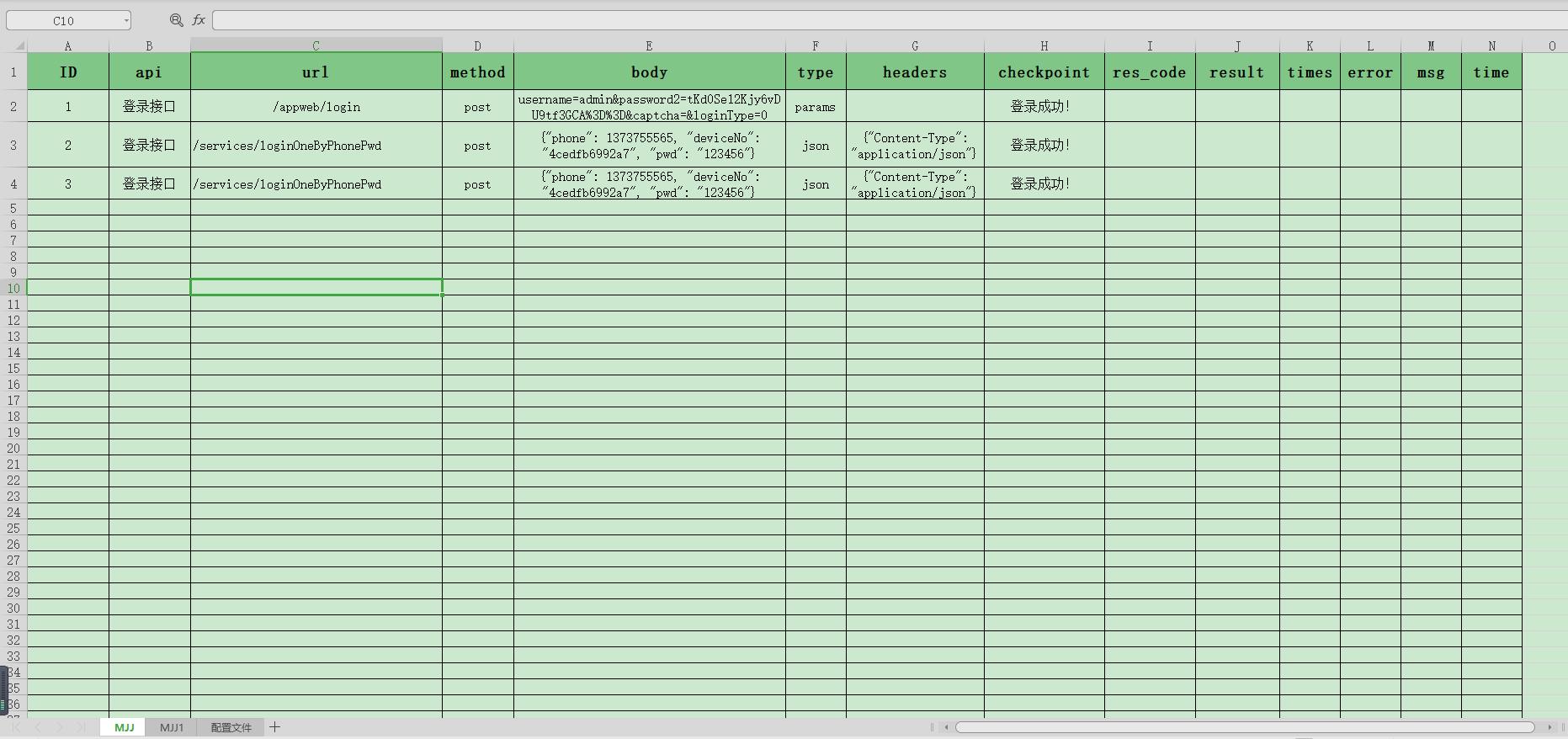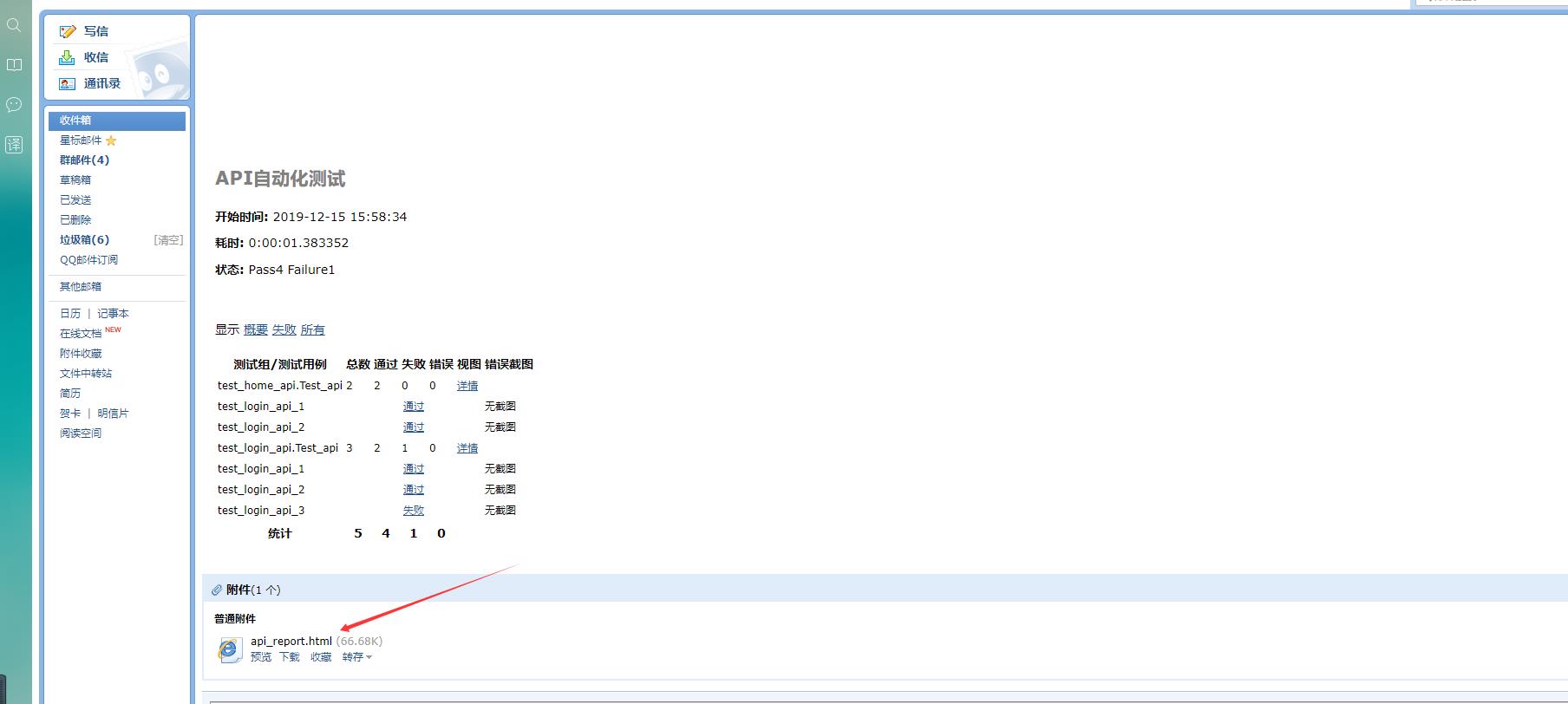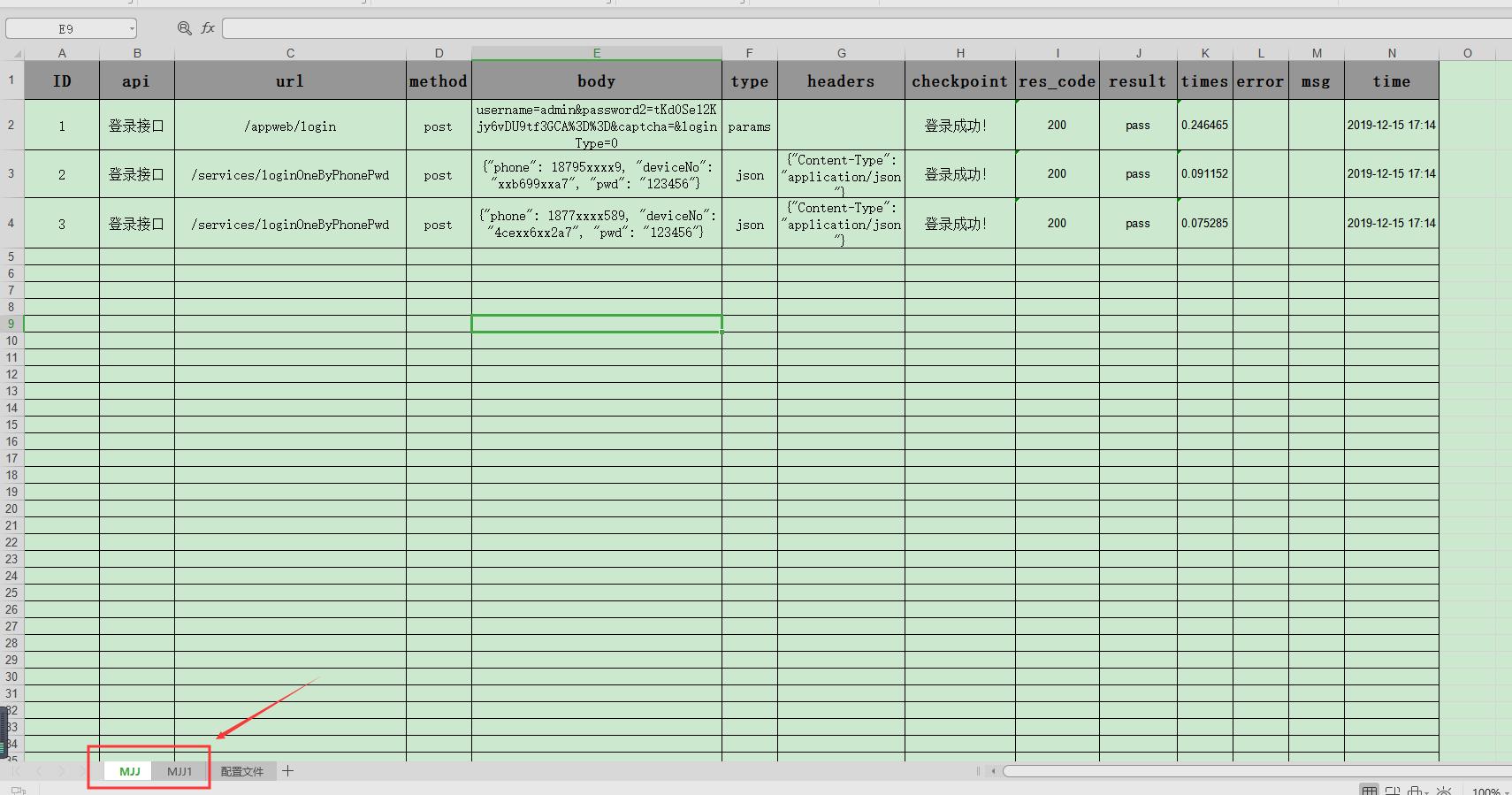python接口自动化10-excel设计模式实战
Posted 广深-小龙 --扬帆起航!
tags:
篇首语:本文由小常识网(cha138.com)小编为大家整理,主要介绍了python接口自动化10-excel设计模式实战相关的知识,希望对你有一定的参考价值。
前言
一、简介
1.环境准备:python+requests+excel+unittest+ddt,主要安装以下环境,其它一般都有了,没有自行安装:
- pip install xlrd
- pip install xlutils
- pip install ddt
- pip install requests
- HTMLTestRunner

2.目前实现的功能:
- 封装requests请求方法
- excel读取接口请求参数,断言结果,支持多个table
- 运行结果新写入一个excel中(很鸡肋,每次看excel报告都要调一下上下居中自动分行等)
- 用unittest+ddt数据驱动模式执行
- HTMLTestRunner生成可视化的html报告
- 用例不通过即发邮件(比较鸡肋,以前用selenium继承下来的)
3.excel,格式如下:

二、封装模块
1.读取excel封装
# coding:utf-8 import xlrd class Excel(): \'\'\'excelPath= excel 的目录路径,sheetName = 自定义table\'\'\' def __init__(self, excelPath, tableName=\'Sheet1\'): self.data = xlrd.open_workbook(excelPath) self.table = self.data.sheet_by_name(tableName) self.keys = self.table.row_values(0) # 获取第一行作为key值 self.rowNum = self.table.nrows # 获取总行数 self.colNum = self.table.ncols # 获取总列数 def dict_data(self): if self.rowNum <= 1: print("总行数小于1") else: r = [] j = 1 for i in range(self.rowNum-1): s = {} values = self.table.row_values(j) # 从第二行取对应values值 for x in range(self.colNum): s[self.keys[x]] = values[x] r.append(s) j += 1 return r if __name__ == "__main__": data = Excel("G:\\\\python_study\\\\study\\\\excel_demo\\\\cases\\\\接口用例.xls", \'MJJ\') res = data.dict_data()[0] print(res)

2.request封装,和excel写入封装
我这里的‘配置文件’是用例方便切换ip的,看自己的需求。
# coding:utf-8 import json, os, requests,datetime from xlrd import open_workbook from xlutils.copy import copy from study.excel_demo.common.excel import Excel dir_path = os.path.dirname(os.path.dirname(os.path.realpath(__file__))) # 获取模块目录 filename = os.path.join(dir_path, "cases", "接口用例.xls") host_data = Excel(filename, \'配置文件\').dict_data() def send_requests(excel_data,s=requests.session()): \'\'\'封装requests请求\'\'\' host = host_data[0][\'host\'] excel_data = excel_data url = excel_data["url"] method = excel_data["method"] type = excel_data[\'type\'] # 请求头部headers try: headers = eval(excel_data["headers"]) except: headers = None print("*******正在执行用例:----- ID: %s" % int(excel_data[\'ID\'])) print("请求方式:%s, 请求url:%s" % (method, host+url)) # post请求body内容 try: bodydata = eval(excel_data["body"]) except:bodydata = excel_data["body"] # 判断传data数据还是json if type == "json": body = json.dumps(bodydata) elif type == "params": body = bodydata else: body = bodydata if method == "post": print("请求类型为:%s ,body参数为:%s" % (type, body)) res = {} # 接受返回数据 r = s.request(method=method, url=host+url, params=body, headers=headers, data=body,) print("响应信息为:%s" % r.content.decode("utf-8")) res[\'ID\'] = int(excel_data[\'ID\']) res["statuscode"] = str(r.status_code) # 状态码转成str res["text"] = str(r.content.decode("utf-8")) res["times"] = str(r.elapsed.total_seconds()) # 接口请求时间转str if res["statuscode"] != "200": res["error"] = res["text"] else: res["error"] = "" res["msg"] = "" if excel_data["checkpoint"] in res["text"]: res["result"] = "pass" print("用例测试结果: ID: %s---->%s" % (int(excel_data[\'ID\']), res["result"])) else: res["result"] = "fail" res["error"] = res["text"] res[\'time\'] = datetime.datetime.now().strftime("%Y-%m-%d %H:%M") return res def wirte_result(res, report_path, tablename): \'\'\' 1.传需要写入的res 2.report_path:写入的路径 3.tablename \'\'\' excel = copy(open_workbook(report_path, formatting_info=True)) # 将xlrd的对象转化为xlwt的对象 row_nub = res[\'ID\'] # 返回结果的行数row_nub table = excel.get_sheet(tablename) # 获取要操作的sheet table.write(row_nub, 8, res[\'statuscode\']) # 写入返回状态码statuscode,第8列 table.write(row_nub, 9, res[\'result\']) # 测试结果 pass 还是fail table.write(row_nub, 10, res[\'times\']) # 耗时 table.write(row_nub, 11, res[\'error\']) # 状态码非200时的返回信息 table.write(row_nub, 12, res[\'msg\']) # 抛异常 table.write(row_nub, 13, res[\'time\']) # 抛异常 excel.save(report_path) # 保存并覆盖文件
3.test_api用例,支持多个excel的table,在全局变量修改tablename即可。
import unittest,ddt, os from study.excel_demo.common import base from study.excel_demo.common.excel import Excel from xlrd import open_workbook from xlutils.copy import copy dir_path = os.path.dirname(os.path.dirname(os.path.realpath(__file__))) # 获取模块路径 report_path = os.path.join(dir_path, "report", "api_excel测试报告.xls") # 报告生成路径 filename = os.path.join(dir_path, "cases", "接口用例.xls") # 获取excel路径 testdata = Excel(filename, \'MJJ\').dict_data() # tablename excel1 = copy(open_workbook(filename, formatting_info=True)) # 将xlrd的对象转化为xlwt的对象 excel1.save(report_path) # 每次执行前复制用例 @ddt.ddt class Test_api(unittest.TestCase): @ddt.data(*testdata) def test_login_api(self, data): res = base.send_requests(data) base.wirte_result(res, report_path, \'MJJ\') # res写入保存 check = data["checkpoint"] print("检查点---->:%s" % check) # 检查点 checkpoint res_text = res["text"] # 返回结果 self.assertIn(check, res_text) if __name__ == "__main__": unittest.main()
4.run_cases,执行所有用例(发送邮件需申请QQ邮箱或其他邮箱的授权码)
import unittest, time, os, re, sys # 声明路径,这块声明因为我在linux上的jenkins跑回找不到,也就是python的环境变量 cur_path = os.path.dirname(os.path.dirname(os.path.realpath(__file__))) print(cur_path) sys.path.append(cur_path) from common import HTMLTestRunner import smtplib # 负责发送邮件 from email.mime.text import MIMEText # 负责构造邮件的正文 from email.mime.multipart import MIMEMultipart report_name = u\'API自动化测试报告.html\' # 报告名称 report_title = u\'API自动化测试\' # 报告title名称 report_ename = \'api_report.html\' # 附件名称 report_path = os.path.join(cur_path, report_name) # 测试报告目录 def add_case(caseName=\'cases\', rule=\'test*.py\'): \'\'\'第一步:加载所有的测试用例\'\'\' case_path = os.path.join(cur_path, caseName) if not os.path.exists(case_path):os.mkdir(caseName) # 如果不存在这个cases文件夹,就自动创建一个 # 定义 discover 方法的参数,返回测试用例列表文件名 discover = unittest.defaultTestLoader.discover(case_path, pattern=rule, top_level_dir=None) return discover def run_case(all_case, reportName=\'report\'): \'\'\'第二步:执行所有的用例, 把结果写入测试报告\'\'\' report_path = os.path.join(cur_path, report_name) # 测试报告名称 print(\'生成报告目录在:%s\' % report_path) fp = open(report_path, \'wb\') # 加载所有用例,写入测试报告,生成 runner = HTMLTestRunner.HTMLTestRunner(stream=fp, title=report_title, retry=0) runner.run(all_case) # 执行 fp.close() def get_report_html(report_path): \'\'\'第三步:获取最新的测试报告\'\'\' lists = os.listdir(report_path) # 获取report目录下的最新测试报告 lists.sort(key=lambda fn: os.path.getmtime(os.path.join(report_path, fn))) print(u\'\\n最新测试生成的报告: \'+cur_path+lists[-1]) report_file = os.path.join(report_path, lists[-1]) # 找到最新生成的报告文件 return report_file def send_mail(sender, pwd, receiver, smtpserver, report_file, port): \'\'\'发送最新的测试报告内容\'\'\' with open(report_file, "rb") as f: mail_body = f.read() # 定义邮件内容 msg = MIMEMultipart() body = MIMEText(mail_body, _subtype=\'html\', _charset=\'utf-8\') msg[\'Subject\'] = report_title+u\'报告\' msg["from"] = sender if isinstance(receiver, str): msg["to"] = receiver if isinstance(receiver, list): msg["to"] = \',\'.join(receiver) # 加上时间戳,显示报告的内容 time.strftime(\'%a, %d %b %Y %H_%M_%S %z\') msg.attach(body) # 邮箱添加附件 att = MIMEText(open(report_file, "rb").read(), "base64", "utf-8") att["Content-Type"] = "application/octet-stream" att["Content-Disposition"] = \'attachment; filename= %s\' % report_ename msg.attach(att) try: smtp = smtplib.SMTP() # 登录邮箱 smtp.connect(smtpserver) # 连接邮箱服务器 smtp.login(sender, pwd) # 用户名密码 except: smtp = smtplib.SMTP_SSL(smtpserver, port) smtp.login(sender, pwd) # 登录 smtp.sendmail(sender, receiver, msg.as_string()) smtp.quit() print(\'测试报告电子邮件已发送!\') def read_report(): \'\'\' 判断是否发送邮件,读取报告判断是否存在:Failure、error、还有可能整个文件是空 \'\'\' ret = [] with open(report_path, \'rb\')as f: f = f.read() res_Failure = re.findall(b\'class="tj failCase">(.+?)<\', f) res_error = (re.findall(b\'errorCase">(.+?)</span>\', f)) res_null = (re.findall(b\'tj passCase">Pass</span>(.+?)</p>\', f)) for i in res_error: ret.append(i) for i in res_Failure: ret.append(i) for i in res_null: try: if int(i): return True except:pass return False if __name__ == "__main__": all = add_case() # 加载用例 run_case(all) # 执行用例 report_file = get_report_html(os.path.join(cur_path)) # 获取最新测试报告路径 # 邮箱配置 sender = \'xxxxxxx@qq.com\' pwd = \'rlcfmsgcccgrbejj\' # SSL授权码登录 smtp_server = \'smtp.qq.com\' port = 465 receiver = [\'xxxxx@qq.com\'] # 可多个邮箱传list对象 # 判断报告是否有错误,有错误就发送邮件 ret = read_report() if ret == False: send_mail(sender, pwd, receiver, smtp_server, report_file, port) elif not ret: send_mail(sender, pwd, receiver, smtp_server, report_file, port) else:print(\'用例全部通过,不需要发送邮件\')
这张图是1.0版本的了

三、执行结果展示
1.html 测试报告:

2.失败邮箱接收的报告:

3.excel 测试报告:
当然也是可以参考Page Object模式,更多的是用在selenium UI 自动化测试上,但是我们的api自动化测试也是可以参照这样的设计模式。
1.api:接口请求,及断言封装模块;
2.cases:用例集合;
3.common:配置文件,如环境,封装sql、读取excel操作等;
4.data:测试数据,如ddt;
5.执行用例,测试报告路径

如果要 token 那么直接封装一个获取 token 的函数,读取接口用例的时候将参数token加入或替换进去即可,实在不行你联系我。
说了那么多,还不如玩api平台呢?这是给点点点手下人用的,创建桌面快捷编辑写excel稳得一匹。
欢迎来大家QQ交流群一起学习:482713805 !!!
以上是关于python接口自动化10-excel设计模式实战的主要内容,如果未能解决你的问题,请参考以下文章
